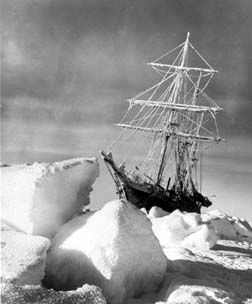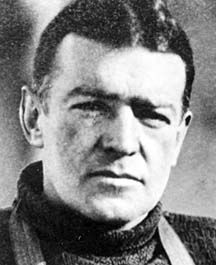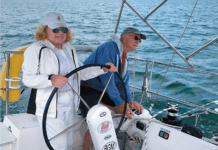In a couple of exciting decades surrounding World War I, the entire world was transfixed by polar expeditions.

It was a different time. There were daring and significant things to do.
Heroes were brave and intrepid.
One of them, Ernest Shackleton, made history’s second greatest small boat voyage. (It’s generally agreed that most incredible was Lt. William Bligh’s 48-day, 3,618-mile passage in a 23′ launch with 18 of his crew after the 1789 mutiny aboard H.M.S. Bounty.) Shackleton sailed 700 miles in a 22′ whaleboat in the world’s stormiest waters.
The Irish-born Shackleton had been third officer under Capt. Robert F. Scott in a 1901-1904 expedition. On an expedition of his own in 1909, Shackleton reached the farthest point south anyone had ever been to that time.
Shackleton was knighted.
Scott was miffed. These men were competitive. Deliberately excluded from Scott’s next voyage, Shackleton moped; he didn’t know how lucky he was. Scott reached the South Pole on January 17, 1912, only to find that Roald Amundsen had run up the Norwegian flag several weeks earlier.
Amundsen, who vanished in 1928 aboard an airplane trying to rescue survivors of Umberto Nobile’s disastrous dirigible flight and crash after a pass over the North Pole, had grabbed the South Pole glory. Peary (1909) had the North Pole honors.
Nevertheless, in 1914, racing to beat World War I (there were comments about using up resources), Shackleton organized one more expedition, for a cross-continent dog sled run from the Weddell Sea to McMurdo Sound, with a stopover at the Pole. It was the last undone intrepidity.
His ship, Endurance, headed south from South Georgia Island on December 5, 1914, but ground to a halt in the pack ice on January 18, 1915.
For 10 months, the 350-ton Endurance drifted with the ice (the crew played football, hockey and chess) before breaking up and sinking. She had drifted 1,186 miles or 573 if measured in a straight line. The 28-man ship’s crew, now in serious trouble, had salvaged what they could and abandoned the ship a few weeks earlier.
With three whale boats loaded with supplies, the crew, rarely dry, alternately sailed the boats and dragged them over the ice, going

with the inexorable flow, for five months before reaching land—a forlorn place called Elephant Island. If they had missed it…
Knowing they were marooned and lost to the world, they prepared the biggest whaleboat, the James Caird (named for one of Shackleton’s financial backers) for a dreaded voyage. The route had to be with the wind and the only downwind place to head for was South Georgia Island. Miss it and everybody is dead. South Georgia is about 30 miles wide and 90 miles long…not much of a target.
The Caird, a standard double-ender, clinker built, had been holed previously and carried a metal patch. Her gunwales were built up 15″, she was recaulked with cotton lamp wick, seals blood and paint.
With five others, Shackleton shoved off on April 24, 1916, into the worst weather in the world.
What the Caird and her crew endured in the next 14 days is scarcely believable, but they made it to South Georgia Island. Unfortunately, their harrowing landfall in a hurricane, rain, hail, sleet and snow, through roaring combers, steering in between huge boulders, was necessarily on the western side, which left them with glacier-covered mountains to conquer before reaching the small whaling settlement at Stromness, on the eastern side of South Georgia. It took the fittest three of the men (including Shackleton) 36 hours of climbing, first up 4,000 feet, then down, to cover the 20 or so miles up and across the Allardyce Mountain Range that ridges South Georgia Island. To the whaling station crew, they didn’t look human.
The rescue, first of the three men left with the Caird, then of the 22 men on Elephant Island, is a tale unto itself. Shackleton died in 1922 of a heart attack on yet another expedition.
It’s all told in two excellent books, both recently re-issued.
Shackleton’s Boat Journey, written by Frank A. Worsley, who was the captain of the Endurance, was re-issued recently by W. W. Norton, 500 5th Ave., New York, New York. 220 pages, $13. South, written by Shackleton, was re-issued in 1998 by The Lyons Press, 123 W. 18 St., New York, New York, 380 pages, $13.95.
Worsley’s is the best reading; South is the most thorough.
It’s become popular to trash heroes—like Thomas Jefferson, Ty Cobb and Hemingway. But no one has managed to put much of a knock on men about whom Sir Edmund Hillary commented: “If it’s science, send Scott. If it’s speed, use Amundsen. If you want to be sure you get back, go with Shackleton.”










































